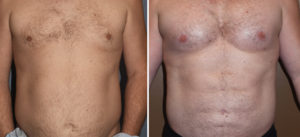Changing the chest of women is a very commonly done plastic surgery procedure, with nearly 350,000 women having the procedure last year in the U.S. Adding up all the women who have had breast augmentation over the past 20 years, it is estimated that about 1 in 7 women between the ages of 21 and 45 now have breast implants. Despite this tremendous chest changing that goes on in women, men do far less of it.
The equivalent of breast augmentation in men is the use of pectoral implants. There are no quoted estimates of the number of pectoral augmentations that are done per year in the U.S.. But it would be fair to say that for every 100 breast augmentations that are done, maybe one pectoral augmentation is done. This low rate is understandable as men have the ability, often times requiring extraordinary effort but possible nonetheless, to make the pectoral muscles bigger and more defined. No amount of exercise in a woman will make their breasts enlarge.
But there are men who simply can not build their pectoral muscles adequately through the natural route. Either through lack of effort, insufficient time or the anatomy and genetics of their chest shape and muscle size, they just can not build up their chest. I have even seen some men who have done well with their biceps and shoulder girdle muscle development but their pectoral muscles lag behind. They have a disporportionate chest shape.
Whatever the reason, the stories I hear are the same for why men explain their desire for surgical chest enhancement. Embarrassment to take their shorts off at the gym, at the pool, or in sports are the most common self-image issues. A flat chest with little pectoral definition and minimal pectoral margins is what you see. It is very uncommon to see a bodybuilder who merely wants to ‘cheat’ to an even larger pectoral muscle profile.


While pectoral implants are placed in the identical manner as the transaxillary saline implant approach, it is critical that they are not positioned on the chest wall like breast implants. Breast implants are positioned well below the lower edge of the pectoral muscle to create the lower pole shape of the breast. Conversely, pectoral implants are placed only down to the level of the lower border of the muscle…and never below. They are actually positioned just above the nipple level. This will avoid the creation of ‘man boobs’. There are numerous stories of inexperienced surgeons with misadventures performing pectoral enhancement using breast implants and placing them too low.
Pectoral implants is gaining in popularity in men but will always lag far behind that of breast augmentation. But men should now that pectoral enhancement is as easily done as breast implants and are just as successful.
Dr. Barry Eppley
Indianapolis, Indiana


